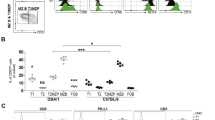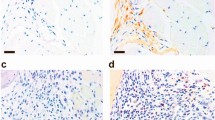Abstract
Antibodies against type II collagen (CII) are essential for development of collagen-induced arthritis (CIA), but how and where the B-cell response to CII is initiated is not fully known. We show here that naive DBA/1 mice display naturally reactive IgM and IgG anti-CII producing B cells prior to immunization. The CII-reactive B cells were observed in the spleen and recognized as marginal zone (MZ) B cells. After CII immunization, CII-specific B cells expanded rapidly in the spleen, in contrast to the lymph nodes, with the initial response derived from MZ B cells and later by follicular (FO) B cells. This was evident despite that the MZ B cells were subject to stringent tolerance mechanisms by having a greater Fc gamma receptor IIb expression than the FO B cells. Further, the MZ B cells migrated to the FO areas upon immunization, possibly providing antigen and activating FO T cells and subsequently FO B cells. Thus, around CIA onset increased numbers of IgG anti-CII producing FO B cells was seen in the spleen, which was dominated by IgG2a- and IgG2b-positive cells. These data demonstrate that CII-reactive MZ B cells are present before and expand after CII immunization, suggesting an initiating role of MZ B cells in the development of CIA.
This is a preview of subscription content, access via your institution
Access options
Subscribe to this journal
Receive 12 digital issues and online access to articles
$119.00 per year
only $9.92 per issue
Buy this article
- Purchase on Springer Link
- Instant access to full article PDF
Prices may be subject to local taxes which are calculated during checkout




Similar content being viewed by others
References
Wooley PH, Luthra HS, Stuart JM, David CS . Type II collagen-induced arthritis in mice. I. Major histocompatibility complex (I region) linkage and antibody correlates. J Exp Med 1981; 154: 688–700.
Nandakumar KS, Andren M, Martinsson P, Bajtner E, Hellstrom S, Holmdahl R et al. Induction of arthritis by single monoclonal IgG anti-collagen type II antibodies and enhancement of arthritis in mice lacking inhibitory Fc gammaRIIB. Eur J Immunol 2003; 33: 2269–2277.
Diaz de Stahl T, Andren M, Martinsson P, Verbeek JS, Kleinau S . Expression of Fc gammaRIII is required for development of collagen-induced arthritis. Eur J Immunol 2002; 32: 2915–2922.
Kleinau S, Martinsson P, Heyman B . Induction and suppression of collagen-induced arthritis is dependent on distinct fc gamma receptors. J Exp Med 2000; 191: 1611–1616.
Venkatesh J, Kawabata D, Kim S, Xu X, Chinnasamy P, Paul E et al. Selective regulation of autoreactive B cells by Fc gammaRIIB. J Autoimmun 2009; 32: 149–157.
Svensson L, Jirholt J, Holmdahl R, Jansson L . B cell-deficient mice do not develop type II collagen-induced arthritis (CIA). Clin Exp Immunol 1998; 111: 521–526.
Cambridge G, Leandro MJ, Edwards JC, Ehrenstein MR, Salden M, Bodman-Smith M et al. Serologic changes following B lymphocyte depletion therapy for rheumatoid arthritis. Arthritis Rheum 2003; 48: 2146–2154.
Rantapaa-Dahlqvist S, de Jong BA, Berglin E, Hallmans G, Wadell G, Stenlund H et al. Antibodies against cyclic citrullinated peptide and IgA rheumatoid factor predict the development of rheumatoid arthritis. Arthritis Rheum 2003; 48: 2741–2749.
Martin F, Kearney JF . Marginal-zone B cells. Nat Rev Immunol 2002; 2: 323–335.
Cesta MF . Normal structure, function, and histology of the spleen. Toxicol Pathol 2006; 34: 455–465.
Martin F, Oliver AM, Kearney JF . Marginal zone and B1 B cells unite in the early response against T-independent blood-borne particulate antigens. Immunity 2001; 14: 617–629.
Oliver AM, Martin F, Gartland GL, Carter RH, Kearney JF . Marginal zone B cells exhibit unique activation, proliferative and immunoglobulin secretory responses. Eur J Immunol 1997; 27: 2366–2374.
Oliver AM, Martin F, Kearney JF . IgMhighCD21high lymphocytes enriched in the splenic marginal zone generate effector cells more rapidly than the bulk of follicular B cells. J Immunol 1999; 162: 7198–7207.
Attanavanich K, Kearney JF . Marginal zone, but not follicular B cells, are potent activators of naive CD4 T cells. J Immunol 2004; 172: 803–811.
Goodyear CS, Silverman GJ . B cell superantigens: a microbe's answer to innate-like B cells and natural antibodies. Springer Semin Immunopathol 2005; 26: 463–484.
Manson JJ, Mauri C, Ehrenstein MR . Natural serum IgM maintains immunological homeostasis and prevents autoimmunity. Springer Semin Immunopathol 2005; 26: 425–432.
Holers VM, Kulik L . Complement receptor 2, natural antibodies and innate immunity: Inter-relationships in B cell selection and activation. Mol Immunol 2007; 44: 64–72.
Rolf J, Motta V, Duarte N, Lundholm M, Berntman E, Bergman ML et al. The enlarged population of marginal zone/CD1dhigh B lymphocytes in nonobese diabetic mice maps to diabetes susceptibility region Idd11. J Immunol 2005; 174: 4821–4827.
Grimaldi CM, Michael DJ, Diamond B . Cutting edge: expansion and activation of a population of autoreactive marginal zone B cells in a model of estrogen-induced lupus. J Immunol 2001; 167: 1886–1890.
Wither JE, Loh C, Lajoie G, Heinrichs S, Cai YC, Bonventi G et al. Colocalization of expansion of the splenic marginal zone population with abnormal B cell activation and autoantibody production in B6 mice with an introgressed New Zealand Black chromosome 13 interval. J Immunol 2005; 175: 4309–4319.
Duan B, Niu H, Xu Z, Sharpe AH, Croker BP, Sobel ES et al. Intrafollicular location of marginal zone/CD1dhi B cells is associated with autoimmune pathology in a mouse model of lupus. Lab Invest 2008; 88: 1008–1020.
Miller EJ . Structural studies on cartilage collagen employing limited cleavage and solubilization with pepsin. Biochemistry 1972; 11: 4903–4909.
Magnusson SE, Andren M, Nilsson KE, Sondermann P, Jacob U, Kleinau S . Amelioration of collagen-induced arthritis by human recombinant soluble Fc gammaRIIb. Clin Immunol 2008; 127: 225–233.
Carsetti R . Characterization of B-cell maturation in the peripheral immune system. Methods Mol Biol 2004; 271: 25–35.
Andren M, Johanneson B, Alarcon-Riquelme ME, Kleinau S . IgG Fc receptor polymorphisms and association with autoimmune disease. Eur J Immunol 2005; 35: 3020–3029.
Cinamon G, Matloubian M, Lesneski MJ, Xu Y, Low C, Lu T et al. Sphingosine 1-phosphate receptor 1 promotes B cell localization in the splenic marginal zone. Nat Immunol 2004; 5: 713–720.
Cinamon G, Zachariah MA, Lam OM, Foss FW, Jr ., Cyster JG . Follicular shuttling of marginal zone B cells facilitates antigen transport. Nat Immunol 2008; 9: 54–62.
Kraal G, Janse M . Marginal metallophilic cells of the mouse spleen identified by a monoclonal antibody. Immunology 1986; 58: 665–669.
Anthony DD, Haqqi TM . Collagen-induced arthritis in mice: an animal model to study the pathogenesis of rheumatoid arthritis. Clin Exp Rheumatol 1999; 17: 240–244.
Mauri C, Williams RO, Walmsley M, Feldmann M . Relationship between Th1/Th2 cytokine patterns and the arthritogenic response in collagen-induced arthritis. Eur J Immunol 1996; 26: 1511–1518.
Okamoto Y, Gotoh Y, Tokui H, Mizuno A, Kobayashi Y, Nishida M . Characterization of the cytokine network at a single cell level in mice with collagen-induced arthritis using a dual color ELISpot assay. J Interferon Cytokine Res 2000; 20: 55–61.
Sakurai Y, Brand DD, Tang B, Rosloniec EF, Stuart JM, Kang AH et al. Analog peptides of type II collagen can suppress arthritis in HLA-DR4 (DRB1*0401) transgenic mice. Arthritis Res Ther 2006; 8: R150.
Bos NA, Kimura H, Meeuwsen CG, De Visser H, Hazenberg MP, Wostmann BS et al. Serum immunoglobulin levels and naturally occurring antibodies against carbohydrate antigens in germ-free BALB/c mice fed chemically defined ultrafiltered diet. Eur J Immunol 1989; 19: 2335–2339.
Gobet R, Cerny A, Ruedi E, Hengartner H, Zinkernagel RM . The role of antibodies in natural and acquired resistance of mice to vesicular stomatitis virus. Exp Cell Biol 1988; 56: 175–180.
Li Y, Li H, Weigert M . Autoreactive B cells in the marginal zone that express dual receptors. J Exp Med 2002; 195: 181–188.
Zeng D, Lee MK, Tung J, Brendolan A, Strober S . Cutting edge: a role for CD1 in the pathogenesis of lupus in NZB/NZW mice. J Immunol 2000; 164: 5000–5004.
Takahashi T, Strober S . Natural killer T cells and innate immune B cells from lupus-prone NZB/W mice interact to generate IgM and IgG autoantibodies. Eur J Immunol 2008; 38: 156–165.
Prockop DJ, Kivirikko KI . Collagens: molecular biology, diseases, and potentials for therapy. Annu Rev Biochem 1995; 64: 403–434.
Brownlie RJ, Lawlor KE, Niederer HA, Cutler AJ, Xiang Z, Clatworthy MR et al. Distinct cell-specific control of autoimmunity and infection by Fc gammaRIIb. J Exp Med 2008; 205: 883–895.
Zheng B, Zhang X, Guo L, Han S . IgM plays an important role in induction of collagen-induced arthritis. Clin Exp Immunol 2007; 149: 579–585.
Noorchashm H, Bui A, Li HL, Eaton A, Mandik-Nayak L, Sokol C et al. Characterization of anergic anti-DNA B cells: B cell anergy is a T cell-independent and potentially reversible process. Int Immunol 1999; 11: 765–776.
Seo SJ, Fields ML, Buckler JL, Reed AJ, Mandik-Nayak L, Nish SA et al. The impact of T helper and T regulatory cells on the regulation of anti-double-stranded DNA B cells. Immunity 2002; 16: 535–546.
Ferguson AR, Youd ME, Corley RB . Marginal zone B cells transport and deposit IgM-containing immune complexes onto follicular dendritic cells. Int Immunol 2004; 16: 1411–1422.
Doncarli A, Stasiuk LM, Fournier C, Abehsira-Amar O . Conversion in vivo from an early dominant Th0/Th1 response to a Th2 phenotype during the development of collagen-induced arthritis. Eur J Immunol 1997; 27: 1451–1458.
Maccioni M, Zeder-Lutz G, Huang H, Ebel C, Gerber P, Hergueux J et al. Arthritogenic monoclonal antibodies from K/BxN mice. J Exp Med 2002; 195: 1071–1077.
Mandik-Nayak L, Racz J, Sleckman BP, Allen PM . Autoreactive marginal zone B cells are spontaneously activated but lymph node B cells require T cell help. J Exp Med 2006; 203: 1985–1998.
Acknowledgements
This research project was supported by the Swedish Research Council and The King Gustav V's 80 years Foundation. For technical assistance, we would like to thank Dr Jan Grawé at the Cell Analysis Core Facility (Rudbeck Laboratory, Uppsala University) for cell sorting, Julie Moran (Department of Cell and Molecular Immunology, Uppsala University) for ELISpot, Sara Lind (Karolinska Institute, Solna) for FACS and finally Professor Birgitta Heyman, Dr Magnus Åbrink (Department of Medical Biochemistry and Microbiology, Uppsala University) and Professor Stellan Sandler (Department of Medical Cell Biology, Uppsala University) for providing the Balb/c, C57BL/6 and NOD mice.
Author information
Authors and Affiliations
Corresponding author
Additional information
Note: Supplementary information is available on the Cellular & Molecular Immunology website.
Supplementary information
Rights and permissions
About this article
Cite this article
Carnrot, C., Prokopec, K., Råsbo, K. et al. Marginal zone B cells are naturally reactive to collagen type II and are involved in the initiation of the immune response in collagen-induced arthritis. Cell Mol Immunol 8, 296–304 (2011). https://doi.org/10.1038/cmi.2011.2
Received:
Revised:
Accepted:
Published:
Issue Date:
DOI: https://doi.org/10.1038/cmi.2011.2
Keywords
This article is cited by
-
Infrared radiation from cage bedding moderates rat inflammatory and autoimmune responses in collagen-induced arthritis
Scientific Reports (2021)
-
Collagen epitope expression on B cells is sufficient to confer tolerance to collagen-induced arthritis
Arthritis Research & Therapy (2016)
-
Activated mast cells promote differentiation of B cells into effector cells
Scientific Reports (2016)
-
Nodal marginal zone B cells in mice: a novel subset with dormant self-reactivity
Scientific Reports (2016)
-
Olfactory ecto-mesenchymal stem cells possess immunoregulatory function and suppress autoimmune arthritis
Cellular & Molecular Immunology (2016)



